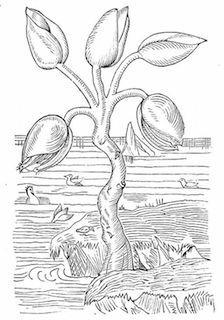 Look out for Goose Barnacles washed up on shore attached to driftwood and other flotsam on the beach, especially after stormy weather.
Look out for Goose Barnacles washed up on shore attached to driftwood and other flotsam on the beach, especially after stormy weather.
Photo: Wikimedia Commons (see main article for full attribution)
Scientific name: Lepas anatifera
Other common names: Common Goose Barnacle
Conservation status: Common
What to look for:
- Colouring and appearance: Oblong-shaped capitulum (shell) formed of five calcareous plates separated by dark reddish-brown to black tissue. A long stalk (peduncle) attaches the barnacle to objects.
- Size: Length 4-5 cm (the peduncle is up to 85 cm long)
- Where: Widespread pelagic crustacean in temperate seas, attached to objects and often found washed ashore on western coasts of Britain.
 We are used to dramatic stormy seas around the Lizard’s coastline. When everything has calmed down again, walks along the shoreline at low tide can be a beachcomber’s paradise, if you can ignore the plastic and other rubbish that has been washed ashore. You might also be able to spot wildlife that has been deposited on the beach by the storms, and one of the most common is the Goose Barnacle.
We are used to dramatic stormy seas around the Lizard’s coastline. When everything has calmed down again, walks along the shoreline at low tide can be a beachcomber’s paradise, if you can ignore the plastic and other rubbish that has been washed ashore. You might also be able to spot wildlife that has been deposited on the beach by the storms, and one of the most common is the Goose Barnacle.
This oblong shaped shellfish, with its five chalk-white, black-lined plates and long stalk, lives in the seas attached to rocks, driftwood or other floating objects. They are notoriously unchoosy about what they attach to – bottles, wood debris, ship hulls are all fine.

Goose Barnacles are hermaphrodites – they have male and female sex organs – producing larvae that swim freely until they attach themselves to an object with their peduncle (stalk). In the sea, they filter food using feathery feeding tentacles, but you won’t see these when they are washed ashore.
Goose Barnacle is a strange name for a shellfish. Centuries ago, ignorance about where some bird species went to in the winter led to some odd beliefs. We now know about migration, but in the Middle Ages and earlier it was thought, for example, that swallows slept through the colder months at the bottom of lakes. In the case of Barnacle Geese, which nest in the Arctic, a similarity between the shape of their head and the Goose Barnacle led to the belief that the birds were born directly as adults from the barnacles in spring. This did at least mean that Barnacle Geese were exempt from the restrictions on eating meat on Fridays and during Lent!
Did you know…?
 …As Goose Barnacles are often found attached to driftwood, people used to believe that there was a species of ‘goose-tree’ on which they grew, producing adult Barnacle Geese. The illustration of the ‘goose-tree’ to the right is from the botanist Gerard’s Herbal, first published in 1597 and widely used for the following two centuries.
…As Goose Barnacles are often found attached to driftwood, people used to believe that there was a species of ‘goose-tree’ on which they grew, producing adult Barnacle Geese. The illustration of the ‘goose-tree’ to the right is from the botanist Gerard’s Herbal, first published in 1597 and widely used for the following two centuries.
Published: November 2015
Author: Amanda Scott
Photos:
Homepage and middle photo this page: Des Colhoun [CC BY-SA 2.0], via Wikimedia Commons
Top: ©Natural England/Peter Wakeley
Below (Goose Barnacles on bottle): By Raiyan (Own work) [CC BY 3.0], via Wikimedia Commons
Image of ‘goose-tree’: author unknown. Source:PSM_V04_D585_The_goose_tree.jpg)

